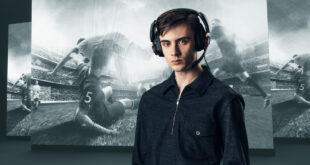[This feature was published in the May 2013 edition of Develop magazine, which is available through your browser and on iPad.]
Some of you may know us – we have been around for a while now, and one of the areas that we have gained a lot of expertise in is car audio. For this article, we are going to share some of the wisdom we have learned over the years. Specifically, the recording process, as this can be extremely challenging.
The following applies for both rolling roads and track recording. Which one of these is best for games is for another article.
STARTERS ORDERS
Firstly, you need microphones; especially some small ones to get into nooks and crannies as you go about the process.
Lavmics are tiny, so can be placed almost anywhere. We use DPA 4062’s. These are omnidirectional, therefore it’s important to get them close to the sound source, otherwise you will get reflections back into the mic, as well as the direct signal.
Pencil-shaped condenser mics are probably next favourite as they are fairly small. We have some DPA 4011’s which are cardoid response (directional). Contact mics can also be useful. Most types of mics will work, as long as they can handle the volume.
You’ll want to get microphones which can handle high SPL. You are placing them close to very loud sources, and when we say close, we mean inches rather than feet.
Additionally, use as many microphones and channels as possible. Car recordings can be expensive, therefore it’s important to capture as much as you can while you have the chance. So throw as many mics and channels at it as you can. We never record less than six, and usually it’s over ten.
A LITHE WIRE
You should also be prepared to be flexible, and mindful that the owner of the car, and track or dyno, are not going to have a clue what you want. Speak to the owner of the car and make sure they are comfortable with what you want to do. You should also communicate this clearly to the driver of the car if they’re not the owner.
You also need to not care about your microphones too much. That may be counterintuitive, but you will need to put these mics into dangerous places if you want the best results. You should also book more time than you think you will need. There are always problems, so be prepared for it to take longer than you thought.
Make sure you attach everything securely. Gaffer tape and cable ties are essential. That applies to both microphones and cables. Before beginning any session, ask yourself ‘is anything going to be flying about once the 100mph air starts flowing?’
Of course, do not put microphones near anything that will get hot. Did you know that microphones turn blue when they get super hot? Cables also melt very readily. Avoid getting too close to exhaust manifolds, turbo units and so on.
You will need wind protection, especially if you are recording on track. Consider buying extra wind protection materials, to wrap around mics if required. Sometimes you cannot avoid massive airflow, but be prepared to try to mitigate the effects.
Certainly, do not put microphones in the direct airflow of the exhaust. This one is surprisingly easy to overlook. At best you will get a windy and fluttery recording; at worst you will roast a microphone.
SOLID ADVICE
And use a solid state recorder. A hard drive recorder may work on quieter cars, but in very loud environments, HD recorders often fail, and they have for us.
Additionally, you should always record at a high bit/sample rate. There will be some post processing when you get back to the studio.
Think about microphone placement. Engine and exhaust are a requirement, but think about what else might make cool sounds; consider turbo, supercharger, gearbox and such.
And vitally, it’s always better with two people. You will need one to manage the recording, and one to direct the driver.
Importantly, you need some nerve. We have seen fires, cars jumping off rolling roads, gearboxes seizing up, bonnets flying off, paint melting, you name it. You will have problems, so be prepared.
Finally, you need some luck. Car recordings can be stressful, and there’s a bit of an art to getting them performed with total success. Cover as many of the points above as you can, and you will have a fighting chance of getting something usable.
To see other articles in our Audio Special series, visit our archive

 MCV/DEVELOP News, events, research and jobs from the games industry
MCV/DEVELOP News, events, research and jobs from the games industry


